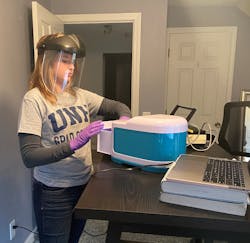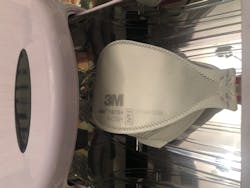UV light method shows promise for sanitizing N95 masks
The number of COVID-19 cases has not yet hit its peak and supplies of essential personal protective equipment (PPE) such as N95 masks are dwindling, so medical communities are desperately looking for alternative solutions for disinfecting masks that healthcare workers are being forced to reuse.
Recognizing this, Jim Malley, professor of civil and environmental engineering at the University of New Hampshire (Durham, NH), says methods like UV light, heat, humidity, and vaporized hydrogen peroxide are the best-known viable practices and while they are not long-term solutions, if used correctly, they can be effective in emergency situations. “UV light offers a potential option that can be a safe and cost-effective way to sanitize masks, if the right amount of light, for the right length of time, is dosed by a well-understood optical device,” says Malley.
Malley has over 30 years of experience using chemical and physical options, in particular UV light, to disinfect water, air, and surfaces from bacteria, viruses, and protozoan cysts. His expertise has helped guide front-line medical practitioners and first responders nationwide looking for facts on the most effective way to use the UV lights. They are being used in hospitals and hanging in ambulances so that EMTs can sanitize their surfaces and implements on the go. Malley estimates that about a third of the calls he receives are from healthcare professionals in rural areas that don’t have the same resources as those in cities.
“A lot of large vaporized hydrogen peroxide systems are being set up in cities around the country to help sanitize masks, but UV is a more feasible low-tech and low-volume option for first responders and individual healthcare workers often found in rural areas,” says Malley. “There are pros and cons to both, but the need is just so great and growing every day from nursing homes to hospitals, labs, and ambulances—these disinfectant options are tools in a toolbox and right now we need to use all the tools we have.”UV light penetrates the mask and works by damaging the molecular bonds that hold together the nucleic acids (DNA or RNA) of the viruses or bacteria and stops them from infecting and/or replicating within a human cell. The UV light used is shortwave and cannot be seen by the human eye so to effectively kill the virus requires an understanding of the irradiance—amount of light energy or UV intensity—the length of time the mask is dosed, and knowledge of the UV optics of the disinfection device.
Malley stresses that it is important that masks are clean because any substance on the inside or the outside of the mask, even something as simple as sunscreen, cosmetics, or lip balm, could block the UV light from working on a particular portion of the mask.
“In a perfect world, masks should be worn once and discarded,” says Malley. “But in a pandemic, with all the supply shortages and strains on healthcare system infection control practices, disinfection practices like heat and humidity applications, ultraviolet light, and/or hydrogen peroxide vapor, offer alternative disinfectant options for PPEs.”
For more information, please visit unh.edu.
Source: University of New Hampshire press release – April 6, 2020

